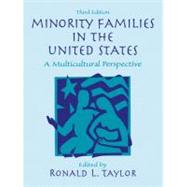
Note: Supplemental materials are not guaranteed with Rental or Used book purchases.
Purchase Benefits
What is included with this book?
Ronald L. Taylor is Professor of Sociology and Vice Provost for Multicultural Affairs at the University of Connecticut, Storrs. He is coauthor and editor (with Doris Y. Wilkinson) of The Black Male in America: Perspectives on His Status in Contemporary Society (1977) and African American Youth: Their Social and Economic Status in the United States (1995). He has published widely on African American families, youth, and gender.
| Contributors | ix | ||||
| Preface | xi | ||||
| Minority Families in America: An Introduction | 1 | (16) | |||
|
|||||
|
3 | (3) | |||
|
6 | (3) | |||
|
9 | (2) | |||
|
11 | (6) | |||
| PART I AFRICAN AMERICAN FAMILIES IN THE UNITED STATES | 17 | (60) | |||
|
19 | (29) | |||
|
|||||
|
22 | (2) | |||
|
24 | (1) | |||
|
25 | (8) | |||
|
33 | (2) | |||
|
35 | (3) | |||
|
38 | (10) | |||
|
48 | (14) | |||
|
|||||
|
48 | (1) | |||
|
48 | (1) | |||
|
49 | (1) | |||
|
50 | (1) | |||
|
51 | (1) | |||
|
52 | (1) | |||
|
53 | (1) | |||
|
54 | (2) | |||
|
56 | (1) | |||
|
57 | (1) | |||
|
58 | (4) | |||
|
62 | (15) | |||
|
|||||
|
63 | (2) | |||
|
65 | (2) | |||
|
67 | (2) | |||
|
69 | (5) | |||
|
74 | (3) | |||
| PART II HISPANIC AMERICAN FAMILIES IN THE UNITED STATES | 77 | (54) | |||
|
79 | (22) | |||
|
|||||
|
|||||
|
81 | (5) | |||
|
86 | (1) | |||
|
87 | (4) | |||
|
91 | (2) | |||
|
93 | (3) | |||
|
96 | (5) | |||
|
101 | (13) | |||
|
|||||
|
102 | (3) | |||
|
105 | (6) | |||
|
111 | (3) | |||
|
114 | (17) | |||
|
|||||
|
114 | (2) | |||
|
116 | (2) | |||
|
118 | (4) | |||
|
122 | (3) | |||
|
125 | (1) | |||
|
126 | (1) | |||
|
127 | (4) | |||
| PART III ASIAN AMERICAN FAMILIES IN THE UNITED STATES | 131 | (94) | |||
|
134 | (30) | |||
|
|||||
|
|||||
|
136 | (15) | |||
|
151 | (7) | |||
|
158 | (6) | |||
|
164 | (17) | |||
|
|||||
|
165 | (3) | |||
|
168 | (6) | |||
|
174 | (3) | |||
|
177 | (4) | |||
|
181 | (12) | |||
|
|||||
|
181 | (2) | |||
|
183 | (2) | |||
|
185 | (2) | |||
|
187 | (3) | |||
|
190 | (3) | |||
|
193 | (19) | |||
|
|||||
|
194 | (3) | |||
|
197 | (4) | |||
|
201 | (2) | |||
|
203 | (2) | |||
|
205 | (3) | |||
|
208 | (4) | |||
|
212 | (13) | |||
|
|||||
|
213 | (2) | |||
|
215 | (1) | |||
|
216 | (1) | |||
|
217 | (2) | |||
|
219 | (1) | |||
|
220 | (5) | |||
| PART IV NATIVE AMERICAN FAMILIES IN THE UNITED STATES | 225 | (25) | |||
|
227 | (23) | |||
|
|||||
|
|||||
|
227 | (3) | |||
|
230 | (5) | |||
|
235 | (3) | |||
|
238 | (2) | |||
|
240 | (6) | |||
|
246 | (4) | |||
| PART V MINORITY FAMILIES AND SOCIAL CHANGE | 250 | (51) | |||
|
252 | (49) | |||
|
|||||
|
255 | (1) | |||
|
256 | (7) | |||
|
263 | (10) | |||
|
273 | (10) | |||
|
283 | (7) | |||
|
290 | (11) | |||
| Index | 301 |
The New copy of this book will include any supplemental materials advertised. Please check the title of the book to determine if it should include any access cards, study guides, lab manuals, CDs, etc.
The Used, Rental and eBook copies of this book are not guaranteed to include any supplemental materials. Typically, only the book itself is included. This is true even if the title states it includes any access cards, study guides, lab manuals, CDs, etc.